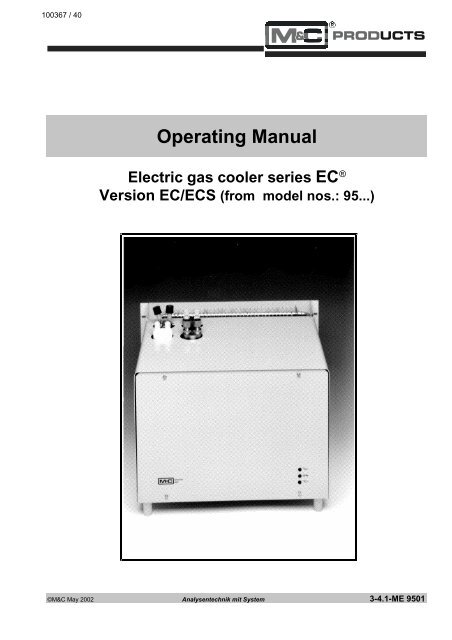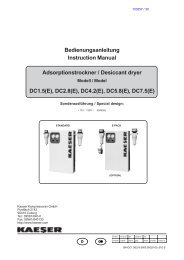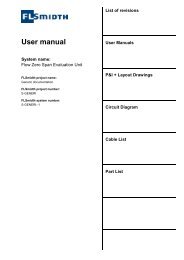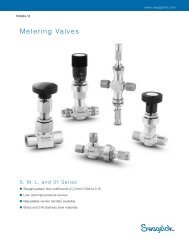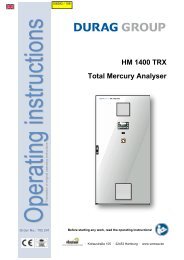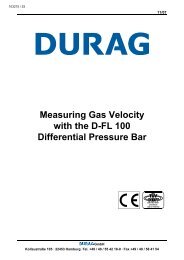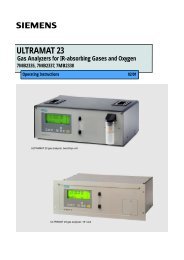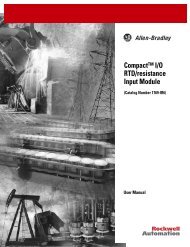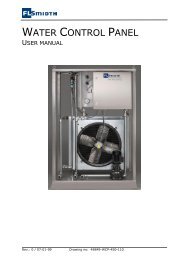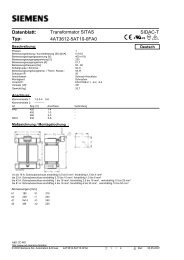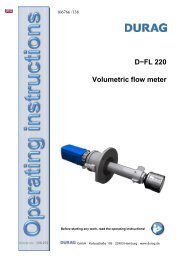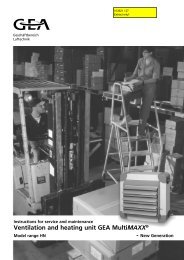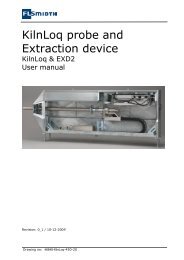EC/ECS
EC/ECS
EC/ECS
Create successful ePaper yourself
Turn your PDF publications into a flip-book with our unique Google optimized e-Paper software.
2Analysentechnik mit System<strong>EC</strong>/<strong>EC</strong>SList of ContentspageSAFETY INSTRUCTIONS...............................................................................................................…. 4USED TERMS AND SIGNAL INDICATIONS....................................................................................… 5⎯⎯⎯⎯⎯⎯⎯⎯⎯⎯⎯⎯⎯⎯1 INTRODUCTION ...................................................................................................................... 62 APPLICATION .......................................................................................................................... 63 T<strong>EC</strong>HNICAL DATA ................................................................................................................... 74 DESCRIPTION ......................................................................................................................... 85 FUNCTION ............................................................................................................................. 106 R<strong>EC</strong>EPTION AND STORAGE ................................................................................................ 117 INSTALLATION INSTRUCTIONS........................................................................................... 118 SUPPLY CONN<strong>EC</strong>TIONS....................................................................................................... 128.1 HOSE CONN<strong>EC</strong>TIONS .......................................................................................................... 128.2 EL<strong>EC</strong>TRICAL CONN<strong>EC</strong>TIONS............................................................................................... 149 START-UP.............................................................................................................................. 169.1 FUNCTION SEQUENCE AND LED FUNCTION DISPLAY ..................................................... 1710 CLOSING DOWN ................................................................................................................... 1811 MAINTENANCE...................................................................................................................... 1811.1 ADDING AND REPLACING THE HEAT EXCHANGERS........................................................ 1912 TROUBLESHOOTING............................................................................................................ 2013 <strong>EC</strong> AUTOMATIC CONTROL BOARD ..................................................................................... 2213.1 CONN<strong>EC</strong>TING THE COOLING COMPRESSOR.................................................................... 2313.2 TEMPERATURE SETTING FOR THE <strong>EC</strong>/<strong>EC</strong>S COOLER...................................................... 2413.3 CONN<strong>EC</strong>TION OF AN EXTERNAL TEMPERATURE READING WITH OPTION.........................“S<strong>EC</strong>OND PT100 SENSOR (PART NO. 02K9500)”................................................................ 2414 CH<strong>EC</strong>KING THE TEMPERATURE SENSOR ......................................................................... 2515 CHANGING THE COOLER AGGREGATE ............................................................................. 2616 SPARE PARTS LIST .............................................................................................................. 2817 APPENDIX.............................................................................................................................. 30Operating Instructions 3-4.1-ME 9501 - Electric Gas Cooler <strong>EC</strong>/<strong>EC</strong>SSubject to technical modifications.© M&C May 2002 Reproduction of this document or its content is not allowed without permission from M&C.
List of IllustrationsAnalysentechnik mit System3pageFigure 1 Example of application of <strong>EC</strong>/<strong>EC</strong>S ................................................................................ 6Figure 2 <strong>EC</strong>/<strong>EC</strong>S with options <strong>EC</strong>-F and <strong>EC</strong>-FD ......................................................................... 8Figure 3 Schematic diagram of functioning of heat exchanger...................................................10Figure 4 Electrical sockets .........................................................................................................14Figure 5 Pin configuration for <strong>EC</strong>/<strong>EC</strong>S .......................................................................................15Figure 6 Pin configuration from model nos. 96... ........................................................................15Figure 7 <strong>EC</strong> automatic control board..........................................................................................22Figure 8 Connection diagram for compressor ............................................................................23Figure 9 Voltage in relation to the temperature of the cooling stage...........................................25Figure 10 Resistance-temperature characteristics of the PT100 temperature sensor ..................25Figure 11 <strong>EC</strong> cooler aggregate ....................................................................................................26Figure 12 Sample outlet dew point ...............................................................................................31Operating Instructions 3-4.1-ME 9501 - Electric Gas Cooler <strong>EC</strong>/<strong>EC</strong>SSubject to technical modifications.© M&C May 2002 Reproduction of this document or its content is not allowed without permission from M&C.
4Analysentechnik mit SystemIMPORTANT SAFETY INFORMATION!! Standard of electrical equipment corresponds to EN 61010 !Please note the following basic safety procedures when using this equipment:____________________________________________Read these operating instructions carefully before start-up and use of the equipment. Theinformation and warnings given in these Operating Instructions must be heeded.Work on electrical equipment is only to be carried out by trained specialists as per the regulationscurrently in force.Attention must be paid to the requirements of I<strong>EC</strong> 364 (DIN VDE 0100) when setting high-powerelectrical units with nominal voltages of up to 1000 V, together with the associated standards andstipulations.Check the details on the type plate to ensure that the equipment is connected up to the correct mainsvoltage.Protection against touching dangerously high electrical voltages.Before opening the equipment, it must be switched and hold no voltages. This also applies to anyexternal control circuits that are connected.The equipment is only to be set within the permitted range of temperatures and pressures.Check that the location is weather-protected. It should not be subject to either direct rain or moisture.The equipment may not be operated in an area at risk from explosion.Installation, maintenance, monitoring and any repairs may only be done by authorized personnel withrespect to the relevant stipulations.If the equipment fails, please contact M&C directly or else go through your M&C authorized dealer.We offer a one-year warranty as of the day of delivery as per our normal terms and conditions of sale,and assuming technically correct operation of the unit. Consumables are hereby excluded. The terms ofthe warranty cover repair at the factory at no cost or the replacement at no cost of the equipment free exuser location. Reshipments must be send in a sufficient and proper protective packaging.Operating Instructions 3-4.1-ME 9501 - Electric Gas Cooler <strong>EC</strong>/<strong>EC</strong>SSubject to technical modifications.© M&C May 2002 Reproduction of this document or its content is not allowed without permission from M&C.
Analysentechnik mit System5USED TERMS AND SIGNAL INDICATIONSSKILLED STAFFThese are persons with necessary qualification, who are familiarwith installation, use and maintenance of the product.WARNING!The signals are used according to DIN 4844 andEU Recommendation 91/C53/06.NOTE!These are important information about the product or parts of theinstruction manual which require user’s attention.Operating Instructions 3-4.1-ME 9501 - Electric Gas Cooler <strong>EC</strong>/<strong>EC</strong>SSubject to technical modifications.© M&C May 2002 Reproduction of this document or its content is not allowed without permission from M&C.
6Analysentechnik mit System1 INTRODUCTIONThe patented M&C <strong>EC</strong>/<strong>EC</strong>S gas cooler unit is always to be installed in situations where there isinterference from moisture in the gas to be measured.Reduction of the gas temperature inside the cooler to a stable and very low dew point effects acondensing-out of the sample gas.2 APPLICATIONFigure 1 shows a typical example of an application for installation of an <strong>EC</strong>/<strong>EC</strong>S gas cooler unit."Sample gasin%<strong>EC</strong>+5°C!# $*CheckgasinCollecting vessel&)' (# Filter sample probe SP... * 3-way ball valve ' Super-fine filter FP...$ Heated sample line & Peristaltic pump ( Aerosol filter CLF% <strong>EC</strong>/<strong>EC</strong>S cooler ) Membrane pump ! Flow meter FM 10" AnalyserFigure 1 Example of application of <strong>EC</strong>/<strong>EC</strong>SThe gas to be measured is taken from the <strong>EC</strong>/<strong>EC</strong>S gas cooler % by a gas sample probe # andcooled down to a dew point of +5°C. The super-fine filter ' located afterwards removes solidparticles. For increased operating safety of the entire system we recommend installing a super-finefilter ' with a liquid alarm sensor. If required an aerosol filter ( can be installed in front of the flowmeter !. The gas thus treated can now be passed into the analyser ".Operating Instructions 3-4.1-ME 9501 - Electric Gas Cooler <strong>EC</strong>/<strong>EC</strong>SSubject to technical modifications.© M&C May 2002 Reproduction of this document or its content is not allowed without permission from M&C.
Analysentechnik mit System73 T<strong>EC</strong>HNICAL DATASample outlet dew pointadjustable 0°C to 20°C, pre-adjusted +5°C (±1°C) by factoryDew point stability±0,25°C ( at inlet dew point 40°C and flow rate 250l/h)Sample inlet temperature **Max. + 180°CSample inlet dew point**Max. +80°CGas flow rate per heat exchanger **Max. 250l/hNumber of heat exchangers 1*, installation of max. 4 heat exchangers possibleMaterial of heat exchangers Duran glass or PVDF or stainless steel 316Ambient temperature**+5 to +45°Cwith option <strong>EC</strong>-F and <strong>EC</strong>-FD: +5°C to +50°CAdmissible gas pressurewith glass and PVDF: max. 3 barwith stainless steel : 10 bar*with option <strong>EC</strong>-FD : 1,2 barTotal cooling powerMax. 520 KJ/h at +25°CDead volume per heat exchanger 70 mlSample gas connection glass:PVDF:For tube ∅ 6mm*,option: 8mm, 10mm or hose connectorG 1/4“i,option: hose connectorstainless steel: G 1/4“i*,option: NPT or hose connectorCondensate connection glass:PVDF:For tube ∅ 12mm*,option: 8mm, 10mm or hose connectorG 3/8“i,option: hose connectorstainless steel: G 3/8“i*,option: NPT or hose connectorReady for operation< 30 minutesPower consumption 280VA, start up current at 230V = 7,9AMains power supply 230V 50Hz +/- 10% *, or: 115V 60Hz +/- 10%Electrical connectionsTerminal 2,5 mm²Status alarm2 changeover contacts, max. 250V 2A AC/DC 500VA, 50WProtection for casing IP 20 (EN 60529)Casing colour RAL 7032Method of mounting19“ rack or wall mountingCasing dimensions<strong>EC</strong> : 84 TE x 7 HE x 450mm, 32kg<strong>EC</strong>S: 84TE x 7 HE x 360mm, 31 kgRefrigerant 230V: R290 100% CFC and FC free115V: R404A 100% CFC freeElectrical equipment standard EN 61010Patent no.: 35 28 268* standard** maximum values in technical datas must be rated in consideration of total cooling power at 25°C.Operating Instructions 3-4.1-ME 9501 - Electric Gas Cooler <strong>EC</strong>/<strong>EC</strong>SSubject to technical modifications.© M&C May 2002 Reproduction of this document or its content is not allowed without permission from M&C.
8Analysentechnik mit System4 DESCRIPTIONFigure 2 shows the <strong>EC</strong>/<strong>EC</strong>S cooler unit with the optional universal units <strong>EC</strong>-F and <strong>EC</strong>-FD.* necessary locating distance465 84 TE88 * 2HE435<strong>EC</strong> 450<strong>EC</strong>S 36037,5857024047 HE23531056,2355443°C>ON°C
Analysentechnik mit System9The <strong>EC</strong>/<strong>EC</strong>S # is equally suitable for wall installation or mounting in a 19“ rack.The versions differ in the positioning of the LED function display $. While for wall installation the LEDfunction display $ can be fitted into the corresponding cut-outs in the <strong>EC</strong>/<strong>EC</strong>S front panel, for 19”rack mounting this is done using the cut-outs in the back panel of the casing. This positioning can bedone at the factory by when stating the type of installation of the <strong>EC</strong>/<strong>EC</strong>S gas cooler. It is relativelysimple to subsequently reconfigure it on site at the user location. The location for installation of theLED function display $ will be marked correspondingly.The casing depth of the <strong>EC</strong>-.. cooler is 450mm and with it there is enough space for mountingperistaltic pumps for automatic condensate removal in the casing.The <strong>EC</strong>S cooler unit differs in its less casing depth of 360mm. Additional installations within the casingaren’t possible. Maximum 4 peristaltic pumps for automatic condensate removal can optional bemounted external on the side panel of the <strong>EC</strong>S casing.On the upper side of the cooler casing you will see the cut-outs & for maximum 4 heat exchangers.Sample gas enters and leaves the heat exchangers by the correspondingly connections on the upperpart of the heat exchangers.At the rear part of the casing the condenser * to remove heat given off in the compressor can beseen.The mains power connector, <strong>EC</strong> automatic control board and the contact outputs for the status alarmare located in the plastic housing % behind the removable front panel of the <strong>EC</strong>/<strong>EC</strong>S casing.On the underside of the casing the following connections are provided as standard:) Standard condensate outlets from the heat exchangers respectively,' Cable glands PG 13,5;As standard, the condensate is removed externally with collecting vessels, peristaltic pumps SR25.1,or by “over-pressure operation”, with automatic drawing-off of condensate, as e.g. type AD-... .The heat energy from the cooling system is drawn off by a forced-ventilation *. The required fans !and large air suction filter elements are provided as standard in This is arranged below the <strong>EC</strong>/<strong>EC</strong>Scasing and is absolutely essential for operation of the cooler unit.Optionally, the automatic condensate removal unit <strong>EC</strong>-FD (10) with maximum 4 peristaltic pumpsSR25.1 (13) can by mounted by factory below the casing of the <strong>EC</strong>/<strong>EC</strong>S cooler. The fans ! and largeair suction filter elements guarantee the above-mentioned condenser forced ventilation and makeoperation at higher ambient temperatures up to +50°C possible. The connection for the commoncondensate outlet (12) is located in the front panel of the <strong>EC</strong>-FD unit.Instead of the unit <strong>EC</strong>-FD the universal unit <strong>EC</strong>-F ( optionally can be used fo operation at higherambient temperatures up to +50°C without automatic condensate removal. The unit is mounted byfactory below the casing of the <strong>EC</strong>/<strong>EC</strong>S cooler and contains as well the above- mentioned fans ! withlarge air suction filter elements.NOTE!From model nos. 96... the power and alarm connection has to be done bycustomer at clamp connection X0 (see 8.2), that is located on the bottom plate ofthe <strong>EC</strong>/<strong>EC</strong>S cooler housing.Operating Instructions 3-4.1-ME 9501 - Electric Gas Cooler <strong>EC</strong>/<strong>EC</strong>SSubject to technical modifications.© M&C May 2002 Reproduction of this document or its content is not allowed without permission from M&C.
10Analysentechnik mit System5 FUNCTIONThe patented M&C <strong>EC</strong>/<strong>EC</strong>S gas cooler is a compressor cooler with status alarm capability. Thisensures 100% availability of the cooler.Up to 4 Jet-stream heat exchangers made of Duran glass, PVDF or stainless steel are located in aheat-insulated cooling block. All the heat exchangers are easily accessible and are arranged in such away that they can be removed very simply.Figure 3 shows a schematic diagram of the functioning of the heat exchanger..Sample gasoutSample gasinCoolingblock+5°CCondensate outFigure 3 Schematic diagram of functioning of heat exchangerThe compressor cooler system has a heat-insulated cooling block at a constant temperature of +5°C.Control of the compressor for models as from serial numbers 95... is done contactless by the <strong>EC</strong>automatic control electronics and is therefore not subject to wear.The novel construction of the heat exchanger guarantees a very good pre-separation of condensateand for that reason an optimal drying of sample gas.Alarm warnings for over- and under-temperature are given as a collective status alarm via a relayoutput with two potential-free changeover contacts. Alarm will be released if the current temperature isout of a range of ±3°C referring to the set-temperature (+5°C) .Operating Instructions 3-4.1-ME 9501 - Electric Gas Cooler <strong>EC</strong>/<strong>EC</strong>SSubject to technical modifications.© M&C May 2002 Reproduction of this document or its content is not allowed without permission from M&C.
Analysentechnik mit System116 R<strong>EC</strong>EPTION AND STORAGEThe <strong>EC</strong>/<strong>EC</strong>S gas cooler is a complete pre-installed unit.• Carefully inspect the <strong>EC</strong>/<strong>EC</strong>S and any special accessories included with it immediately on arrivalby removing them from the packing and checking for missing articles against the packing list!• Check the items for any damage in transit and, if required, inform the shipping insurance companyimmediately of the damage found!NOTE!The cooler must be stored in a weather-protected frost-free area!NOTE!During transport and when in storage, the cooler must always be stood up withthe transport feet positioned underneath so that the oil in the closed compressorcircuit cannot run out of this compressor case. If the cooler is transported on itsback by mistake, it must stood in the operating position for approx. 24 hoursbefore it is switched on!7 INSTALLATION INSTRUCTIONSThe <strong>EC</strong>/<strong>EC</strong>S cooler is equally suitable for wall mounting or for installation in a 19" rack.NOTE!Please state the desired type of mounting when ordering so that the LED functiondisplay can be positioned to match at the factory!NOTE!The operating position for this cooler is exclusively vertical. This is the only way toensure proper separation and removal of condensate in the heat exchangers.During transport and installation, the cooler must always be stood up with thetransport feet positioned underneath so that the oil in the closed compressorcircuit cannot run out of the compressor case.The cooler should be kept away from sources of heat and well ventilated wheninstalled, so that condensation from warmth will not occur and interfere withoperation.The minimum installation dimensions (fig. 2) must be followed without fail. If theunit is installed in the open, the cooler must be installed in a housing that is frostfreein winter and adequately ventilated in summer. Avoid locating the unit indirect sunlight.Unheated gas sample lines must be provided with slope up to the cooler. In thatcase pre-separation of the condensate is not required.Connect the heated sample line with sufficient thermal decoupling to the cooler!Operating Instructions 3-4.1-ME 9501 - Electric Gas Cooler <strong>EC</strong>/<strong>EC</strong>SSubject to technical modifications.© M&C May 2002 Reproduction of this document or its content is not allowed without permission from M&C.
12Analysentechnik mit System8 SUPPLY CONN<strong>EC</strong>TIONS8.1 HOSE CONN<strong>EC</strong>TIONSThe hoses for the heat exchangers are laid out as per Figure 3.NOTE!Do not mix up the hose connections; the inlet and outlet connections of the heatexchangers are marked with arrows;Ensure that the connections are sealed adequately;To ensure free removal of the condensate, ensure that the listed diameters for thecondensate removal lines are not reduced!The connection for sample gas inlet and outlet happens on the upper part of the heat exchangers. Forpossible connectors see technical data (3.).⎯⎯ ⎯ Correspondingly tube or hose connectors are optional available by M&C ⎯⎯ ⎯Ensure that the connections are sealed adequately by noting the following:⎯⎯ ⎯ Duran glass heat exchangers with connections GL 18-6 respectively GL 25-12• Before assembly, check the GL coupling rings to see if the PTFE/silicon locking rings have beendamaged.• To grant a functional and unproblematic mounting we recommend to use union pieces with taperpipe thread type R according to DIN 2999/1 in connection with suitable sealing tape.• The sealing rings should be installed with the PTFE side facing the medium.⎯⎯ ⎯ PVDF respectively stainless steel heat exchangers with G 1/4“i respectively G 3/8“i• The correspondingly dimensioned tube respectively hose couplings with threaded connectionshave to be screwed in with PTFE thread sealing tape.NOTE!When fixing the connectors in the PVDF heat exchanger hold up with a wrench atthe pane of the bolt head!⎯⎯ ⎯ Option: stainless steel heat exchanger with NPT• The heat exchangers with NPT threaded connectors are marked with circulated notches.• The NPT thread must be screwed in with sealant or fixed with adhesive.In the standard configuration, the tubes for removal of condensate are connected directly to the heatexchangers. These protrude with the GL 25-12 tube connectors* (Duran glass heat exchanger)respectively with G 3/8“* thread joint (PVDF or stainless steel heat exchanger) above the base plate ofthe cooler casing (Fig.2).Condensate removal is done by customer according to the type of operation with:- Automatic float-type condensate traps AD-... only for over-pressure operation;NOTE!Stainless steel heat exchangers with G 3/8“ thread joint can be directly fitted upwith the float-type condensate trap AD-SS by means of a thread adapter partnumber FF 11000 (1/2“ NPT to G 3/8“i). By this wall mounting of the AD-SS unitisn’t necessary!- Condensate collector container that is emptied manually;- External peristaltic pump.⎯⎯ ⎯ Option: automatic condensate removal with peristaltic pump SR25.1Operating Instructions 3-4.1-ME 9501 - Electric Gas Cooler <strong>EC</strong>/<strong>EC</strong>SSubject to technical modifications.© M&C May 2002 Reproduction of this document or its content is not allowed without permission from M&C.
Analysentechnik mit System13The Universal unit <strong>EC</strong>-FD is equipped with a condensate outlet for 4/6mm hose connection.Mounting the peristaltic pumps within the cooler casing the common 4/6mm condensate outlet islocated at the base plate of the casing.If the peristaltic pumps for automatic condensate removal are mounted external on the side panel ofthe <strong>EC</strong>S casing the common 4/6mm condensate hose connector is located in the side mounted cablechannel.* standardOperating Instructions 3-4.1-ME 9501 - Electric Gas Cooler <strong>EC</strong>/<strong>EC</strong>SSubject to technical modifications.© M&C May 2002 Reproduction of this document or its content is not allowed without permission from M&C.
14Analysentechnik mit System8.2 EL<strong>EC</strong>TRICAL CONN<strong>EC</strong>TIONSWARNING!WHEN CONN<strong>EC</strong>TING THE EQUIPMENT, PLEASE ENSURETHAT THE SUPPLY VOLTAGE IS IDENTICAL WITH THEINFORMATION PROVIDED ON THE MODEL TYPE PLATE.NOTE!Attention must be paid to the requirements of I<strong>EC</strong> 364 (DIN VDE 0100) whensetting high-power electrical units with nominal voltages of up to 1000 V, togetherwith the associated standards and stipulations.Check the details on the type plate to ensure that the equipment is connected upto the correct mains voltage.The main circuit must be equipped with a fuse of 10A T (over current protection);for electrical details see technical data.Figure 4 shows the electrical connections at the plastic housing behind the front panel of the <strong>EC</strong>/<strong>EC</strong>Scasing (Fig. 2).<strong>EC</strong> automaticcontrol electronicsSupplymain181920LNPEStatus alarmNC MCNO NCMCNO27 28 29 30 31 32Clamp connection X0 (from model nos. 96...)<strong>EC</strong>S<strong>EC</strong>to PG 13,5 to PG 13,5Figure 4 Electrical socketsPower supply : 230V/50Hz or 115V/60Hz (see type plate)Status alarm : two potential free changeover contactsContact rating : 250V AC, 2A, 500VA or250V DC, 2A, 50WThe power connector is on the front panel of the <strong>EC</strong> automatic control board. This is within the plastichousing, behind the removable front panel of the cooler unit. The pin arrangement of the powerconnector is as shown below (Fig. 7):Terminal 18 19 20<strong>EC</strong> automatic control boardConnection L N PEOperating Instructions 3-4.1-ME 9501 - Electric Gas Cooler <strong>EC</strong>/<strong>EC</strong>SSubject to technical modifications.© M&C May 2002 Reproduction of this document or its content is not allowed without permission from M&C.
Analysentechnik mit System15The potential-free contacts of the status collector alarm are located as well on the <strong>EC</strong> automaticcontrol board (Fig. 6), pins 27 to 32.Two PG 13.5 cable glands are provided for the cable bushings through the base plate of the coolercasing. Further details are given in the pin configuration in Figure 5 below.171615141332NO31MC30NC29NO28MC27NCUniversaleinheit <strong>EC</strong>-FD s. AnhangUniversal unit <strong>EC</strong>-FD see appendix<strong>EC</strong>-SensorPT 100The 115V aggregate is forcedventilated by connecting thefan (90 K 0042a) to terminals41, 45 respectively 49 or usingoptional the universal units<strong>EC</strong>-F/FD.4schwarz 3black2schwarz1black43 514742 504641 494540 484424 221 1 2322 318 2019L N PERegelelektronik <strong>EC</strong>/<strong>EC</strong>S<strong>EC</strong>/<strong>EC</strong>S AutomaticControl electronics
16Analysentechnik mit System9 START-UPThe automatic control electronics of the <strong>EC</strong>/<strong>EC</strong>S permit automatic start-up of the cooler. The errordiagnostics guarantee full monitoring and reporting of possible sources of error.The following description is valid for start-up of the gas cooler for an ambient temperature > 8°C.NOTE!Before starting up the gas cooler, it must be placed i its operating position for atleast two hours. The liquid inside the system may have been redistributed, andthis could cause problems in operating!The following steps should be carried out before initial start-up:• Connect the cooler unit to the mains power supply;• Check that the equipment is connected to the correct mains voltage, 115V or 230V, as shown onthe type plate!• Lead the status contacts for reporting of under- and over-temperature to the measuring station;NOTE!The status contacts must be connected to the external sample gas pump or to avalve in the sample gas line to protect the entire analysis system by immediatelycutting off the gas supply in the event of error messages from the cooler!Operating Instructions 3-4.1-ME 9501 - Electric Gas Cooler <strong>EC</strong>/<strong>EC</strong>SSubject to technical modifications.© M&C May 2002 Reproduction of this document or its content is not allowed without permission from M&C.
Analysentechnik mit System179.1 FUNCTION SEQUENCE AND LED FUNCTION DISPLAYThree function display LEDs are provided to give a visualization of the function sequence during startupof the cooler. According to the type of installation, they are located either on the front panel or theback panel of the cooler (Fig. 2). The top LED (red) indicates that the temperature set by the <strong>EC</strong>automatic control electronics has been exceeded or has not been reached. The two-colour(pink/green) LED in the middle shows that the cooler compressor is operating. The bottom redfunction display LED gives an alarm if the temperature falls too low.°C >redSwitching the cooler onAs soon as there is a mains voltage, the top red LED lights up. Thisindicates that the temperature of the cooler is above +8°C. The twocolouredLED in the middle lights up as pink once the coolercompressor is in operation.ON°C ON°C
18Analysentechnik mit System10 CLOSING DOWNNOTE!The location for the cooler must remain frost-free, even when the unit has beenswitched off!If the cooler unit is putting out of action for a short time no particular measures need to be taken.We recommended sweeping the cooler with inert gas or ambient air while the unit is putting out ofaction for a longer time.WARNING!AGGRESSIVE CONDENSATE IS POSSIBLE.WEAR PROT<strong>EC</strong>TIVE GLASSES AND PROPER PROT<strong>EC</strong>TIV<strong>EC</strong>LOTHING!11 MAINTENANCEThe safety instructions specific to the plant and process are to be consulted prior to any maintenancework!WARNING!IT IS N<strong>EC</strong>ESSARY TO TAKE THE <strong>EC</strong>P EL<strong>EC</strong>TRIC GAS COOLEROFF THE MAINS BEFORE ANY ASSEMBLY, MAINTENANCE ORREPAIR WORK IS CARRIED OUT !The <strong>EC</strong>/<strong>EC</strong>S cooler unit does not require any special maintenance intervals.───────────────────────────────── Option ─────────────────────────────────The air suction filter units in the <strong>EC</strong>- F / <strong>EC</strong>-FD universal unit are to be cleaned or replaced accordingto the contamination level of the ambient air. They are located in a plug-in box underneath the coolerunit. The filter elements are removed as follows:• Unclamp the plug-in box by turning the quick-lock screw plug 90° to the left;• Pull out the box;• Remove the crossbars holding the filter element by pulling with moderate force in the direction ofthe filter element axis;• Remove and replace the filter elements.Reassembly is done in the reverse order.Operating Instructions 3-4.1-ME 9501 - Electric Gas Cooler <strong>EC</strong>/<strong>EC</strong>SSubject to technical modifications.© M&C May 2002 Reproduction of this document or its content is not allowed without permission from M&C.
Analysentechnik mit System19When using automatic condensate removal by means of peristaltic pumps, the hoses of the peristalticpumps must be checked every three or six months, depending on the operating conditions, andreplaced if necessary. The procedure for changing the hoses is given in the corresponding operatinginstruction SR25.1 (Appendix).11.1 ADDING AND REPLACING THE HEAT EXCHANGERSRemoval of the heat exchangers may be necessary to carry out maintenance or repair work.We recommend the following procedures and in this order for replacement of the heat exchangers:• Release the upper gas connections and lower condensate connections;• Pull the heat exchangers upwards with rotation out of the cooling block;Replace the heat exchangers as follows:• Dry and clean the push-in opening in the aluminium cooling block with a cloth;• Smear the heat exchangers with a thin and equal layer over the whole surface with thermalconductivity paste (part no. 90K0115) to ensure good conduction of heat. It is best to close off thecondensate removal of the heat exchangers tube with adhesive tape to prevent any of the thermalconductivity paste from getting into the heat exchanger;• Lightly push the heat exchangers with rotation back into the push-in opening of the cooling blockand press to the upper block;• Remove the adhesive tape and any surplus thermal conductivity paste;• Reconnect the hoses.NOTE!Do not mix up the hose connections; gas outlet and gas inlet are marked witharrows!Mounting the Duran glass heat exchangers please notice:• Check the PTFE/Silicon locking rings for damage. in assembly, the locking rings must have thePTFE side facing the medium, otherwise the required degree of sealing cannot be guaranteed!• Do up the red GL coupling rings hand-tight by turning them to the right;Operating Instructions 3-4.1-ME 9501 - Electric Gas Cooler <strong>EC</strong>/<strong>EC</strong>SSubject to technical modifications.© M&C May 2002 Reproduction of this document or its content is not allowed without permission from M&C.
20Analysentechnik mit System12 TROUBLESHOOTINGTroubleshooting is made much easier by the LED function display.The following table shows possible reasons for error and how to correct them (not applicable for therunning-up phase of the cooler).LED displayFunction errorand statusalarmEquipmentdoes not cool;Probable causeChecking / Correction°C >ONNo mains power;Check the mains voltage 230V (115V) at pins 18 and19 of the <strong>EC</strong> automatic control electronics;If mains voltage OK:replace defective <strong>EC</strong> automatic control board.°C ON°C ON°C 8°C (>0,8V):Check PT100 temperature sensor (14.);If not OK:Replace sensor;If sensor and electronics OK:Send cooler in for repair.Operating Instructions 3-4.1-ME 9501 - Electric Gas Cooler <strong>EC</strong>/<strong>EC</strong>SSubject to technical modifications.© M&C May 2002 Reproduction of this document or its content is not allowed without permission from M&C.
Analysentechnik mit System21LED displayFunction errorand statusalarmProbable causeChecking / Correction°C >ON°C
22Analysentechnik mit System13 <strong>EC</strong> AUTOMATIC CONTROL BOARDFigure 7 shows the arrangement of the <strong>EC</strong> automatic control board (wiring scheme in Appendix).Figure 7 <strong>EC</strong> automatic control boardOperating Instructions 3-4.1-ME 9501 - Electric Gas Cooler <strong>EC</strong>/<strong>EC</strong>SSubject to technical modifications.© M&C May 2002 Reproduction of this document or its content is not allowed without permission from M&C.
Analysentechnik mit System2313.1 CONN<strong>EC</strong>TING THE COOLING COMPRESSORThe cooling compressor is connected to the <strong>EC</strong> automatic control board (Fig. 7). Figure 8 shows theconnection diagram for the compressor.Condenser230V 80uFArt.Nr.:90K1055115V 160uFArt.Nr.:90K1060Connection cableArt.Nr.: KL0001cable Nr.1PE green/yellowcable Nr.1 from <strong>EC</strong> automatic control board pin 21cable Nr.2 from <strong>EC</strong> automatic control board pin 24cable Nr.3 from <strong>EC</strong> automatic control board pin 22PE green/yellow from <strong>EC</strong> automatic control boardpin 23Control line Art.Nr.: KL0002from <strong>EC</strong> automatic control electronicscable Nr.3Flat pin terminal Art.Nr KS5006cable Nr.2Motor breaker switch:Klixon 230V Art.Nr.: 90K1046Klixon 115V Art.Nr.: 90K1051Cable no. compressor 1 2 3 PEgreen/yellow<strong>EC</strong> automatic controlboard21 24 22 23Figure 8 Connection diagram for compressorOperating Instructions 3-4.1-ME 9501 - Electric Gas Cooler <strong>EC</strong>/<strong>EC</strong>SSubject to technical modifications.© M&C May 2002 Reproduction of this document or its content is not allowed without permission from M&C.
24Analysentechnik mit System13.2 TEMPERATURE SETTING FOR THE <strong>EC</strong>/<strong>EC</strong>S COOLERThe <strong>EC</strong>/<strong>EC</strong>S gas cooler is set at the factory to a regulated temperature of +5°C.Setting of the regulated temperature is done bytrimming potentiometer P3, on the <strong>EC</strong> automaticcontrol board of the cooler. The setting rangecovers from 0°C to 20°C. Turning it to the rightsets a lower temperature, and turning it to the leftsets a higher temperature.RP3UrefUtempCurrent-Temp.R i > 100kΩConnecting an external voltmeter to plugs 2 and 3allows the nominal set temperature to be read offand controlled. A voltage value of 0.1Vcorresponds to a temperature of 1°C.It is possible to measure and control the currenttemperature at measuring sockets 1 and 2.+ °C -C9UrefSetting-Temp.Connect a d.c. voltmeterto terminals 1, 2 and 3!NOTE!Freezing-up in the cooling stage will endanger the operation of the cooler unit. forthis reason the cooler temperature must never fall below 2°C!13.3 CONN<strong>EC</strong>TION OF AN EXTERNAL TEMPERATURE READING WITH OPTION“S<strong>EC</strong>OND PT100 SENSOR (PART NO. 02K9500)”The second PT100 sensor is connected to the clamps 5 and 6 on the clamp block X2 (see fig. 7).The external temperature reading is connected to the clamps 7 and 8. The connection cable is ledthrough one of the cable glands PG13,5 at the bottom plate of the cooler housing.Operating Instructions 3-4.1-ME 9501 - Electric Gas Cooler <strong>EC</strong>/<strong>EC</strong>SSubject to technical modifications.© M&C May 2002 Reproduction of this document or its content is not allowed without permission from M&C.
Analysentechnik mit System2514 CH<strong>EC</strong>KING THE TEMPERATURE SENSORThe <strong>EC</strong>/<strong>EC</strong>S cooler temperature sensor is a PT100 element as from serial numbers 95... . There aretwo methods for checking the PT100 element, as follows:1.) Voltage methodIn order to check the sensor for the cooler currently in operation, the actual voltage at the measuringsockets 1 and 2 of the <strong>EC</strong> automatic control board must be measured as per section 13.2 above.Figure 9 shows the voltage characteristics in relation to temperature. If the measured voltage is insidethe shaded area, the sensor is defective and must be replaced.Voltage43210-1-2-3-30 -20 -10 0 10 20 30 40°CFigure 9 Voltage in relation to the temperature of the cooling stage2.) Resistance methodIn this case the sensor must be disconnected from pins 1 and 2 at the <strong>EC</strong> automatic control board(Fig. 7) and removed from the cooling block. When measuring the resistance of the PT100 element,this must be proportional to the ambient temperature. The resistance-temperature characteristics areshown in Figure 10 below.Ohm117115113111109107105103101999795-10 0 10 20 30 40Figure 10 Resistance-temperature characteristics of the PT100 temperature sensor°COperating Instructions 3-4.1-ME 9501 - Electric Gas Cooler <strong>EC</strong>/<strong>EC</strong>SSubject to technical modifications.© M&C May 2002 Reproduction of this document or its content is not allowed without permission from M&C.
26Analysentechnik mit System15 CHANGING THE COOLER AGGREGATENOTE!Before removing the cooler aggregate disconnect the cooler from all powersupplies;Before mounting the new aggregate check, if voltage corresponds with thespecification on the type plate;changing the cooler aggregate may only be carried out by qualified personnel!According to the cooler version, forced ventilated or not, cooler aggregates with differing quantity ofrefrigerant are available (spare parts list). As a spare part we deliver a complete replacement cooleraggregate (230V- or 115V), including the compressor, vaporizer, condenser, dryer and the capillarytube with the packaged refrigerant (230V R290, 115V R404A). You send us your defective, nondamaged, complete cooler aggregate in a corresponding safe packing carton taking over the costs ofshipping.Figure 11 shows the positioning of the cooler aggregate within the cooler casing.Front viewTop view1 fastening screw cooler aggregate2 fastening screw vaporizer3 terminal for earth cable4 vaporizer5 compressor6 valve for feeding with refrigerant7 condenser8 dryer9 capillary tubeFigure 11<strong>EC</strong> cooler aggregateOperating Instructions 3-4.1-ME 9501 - Electric Gas Cooler <strong>EC</strong>/<strong>EC</strong>SSubject to technical modifications.© M&C May 2002 Reproduction of this document or its content is not allowed without permission from M&C.
Analysentechnik mit System27For changing the cooler aggregate please carry out the following steps:• Remove the heat exchangers (11.1);• Loosen the fastening screws from the front panel of the cooler casing (Fig. 2);• Disconnect the earth wire of the front panel and remove the front panel;NOTE!If the LED function display is fitted in the front panel of the cooler casing (wallmounting) pay attention that the display will not be damaged by removing the frontpanel!• If the LED function display is fitted in the back panel of the cooler casing (19“ version) it must bepull out of the bracket before removing the cooler cover;NOTE!if replacing the LED function display please pay attention to the correct positioning(marked position respectively the connection cable points to the base plate ofthe casing)!• Loosen the fastening screws of the cooler cover;• Before removing the cooler cover disconnect the earth wire;• Disconnect the cooler compressor from the <strong>EC</strong> automatic control electronics (13.1). For thisremove the cap of the plastic housing (Fig. 2) and disconnect the cables from the correspondingterminals (Fig. 5) (replacement cooler aggregate does not include connecting cables).• Disconnect the earth wire at terminal 3;• Loosen the fastening screws 1 of the cooler aggregate;• Loosen screw 2 in the aluminium cooling block (it is covered under the isolation and is not visiblefrom outside). For this push the isolation backwards;• Loosen the vaporizer 4 by vibrations in the middle of the cooling block. If the vaporizer is bind it ispossible to loosen it through a drilling in the base plate of the cooler by means of compressed air;• Lift the complete cooler aggregate (4, 5, 7) out of the cooler casing;The mounting of the replacement cooler aggregate happens in opposite order. For this smear thealuminium distributor block and the vaporizer sufficient with thermal conductivity paste (part number90K0115).After replacing the aggregate the cooler has to be start up according to the instructions given inchapter 9. The cooler temperature can be controlled after approx. 30 minutes by means of athermometer in drilling 10.Operating Instructions 3-4.1-ME 9501 - Electric Gas Cooler <strong>EC</strong>/<strong>EC</strong>SSubject to technical modifications.© M&C May 2002 Reproduction of this document or its content is not allowed without permission from M&C.
28Analysentechnik mit System16 SPARE PARTS LISTWear, tear and replacement part requirements depend on specific operating conditions.The recommended quantities are based on experience and are not binding.Electric gas cooler <strong>EC</strong>/<strong>EC</strong>S(C) consumable parts and (R) recommended spare partsrecommended quantity<strong>EC</strong>/<strong>EC</strong>S being inoperation [years]Part number Description C/R 1 2 302 K 9105 <strong>EC</strong>-G jet stream heat exchangermaterial: Duran glass02 K 9150 <strong>EC</strong>-G-90° jet stream heat exchangermaterial: Duran glass02 K 9200 <strong>EC</strong>-SS jet stream heat exchangermaterial: stainless steel02 K 9250 <strong>EC</strong>-SS/NPT jet stream heat exchangermaterial: stainless steelConnections: sample gas in and out 1/4“NPTicondensate out 3/8“ NPTi02 K 9300 <strong>EC</strong>-PV jet stream heat exchangermaterial: PVDF90 K 0115 <strong>EC</strong> thermal conductivity paste 50 g (-40°C to140°C)90 K 1002 Temperature sensor PT100 for <strong>EC</strong> automaticcontrol electronics from model nos.: 95.......90 K 1007 <strong>EC</strong> automatic control board complete for PT100and contactless compressor controlfrom model nos.: 95.......90 K 0035 Fan (M1/2 - 230V 50Hz)with option <strong>EC</strong>-F/FD90 K 0040 Fan (M1/2 - 115V 60Hz)with option <strong>EC</strong>-F/FDR 1 1 1R 1 1 1R 1 1 1R 1 1 1R 1 1 1R 1 1 2RR - 1 1C - 2 2C - 2 290 K 0042a Fan 90mm X 90mm for <strong>EC</strong> 115V 60Hz C - 2 290 K 1035 Solid-state-Relais "RE2" ASP-204 R - 1 190 K 1010 LED function display with connecting cable R - - 190 K 1015 Cooler aggregate complete with compressor,vaporizer and condenser for <strong>EC</strong>/<strong>EC</strong>S; refrigerantR290, power: 230 V, 50 Hzstandard90 K 1014a Cooler aggregate complete with compressor,vaporizer and condenser for <strong>EC</strong>/<strong>EC</strong>S; refrigerantR404A, forced ventilated, power: 115 V, 60 HzR - - -R - - -Operating Instructions 3-4.1-ME 9501 - Electric Gas Cooler <strong>EC</strong>/<strong>EC</strong>SSubject to technical modifications.© M&C May 2002 Reproduction of this document or its content is not allowed without permission from M&C.
Analysentechnik mit System29Electric gas cooler <strong>EC</strong>/<strong>EC</strong>S(C) consumable parts and (R) recommended spare partsrecommended quantity<strong>EC</strong>/<strong>EC</strong>S being inoperation [years]Part number Description C/R 1 2 390 K 1014 Cooler aggregate complete with compressor,vaporizer and condenser for <strong>EC</strong>/<strong>EC</strong>S; specialquantity of refrigerant R290 for forced ventilation,power: 230 V, 50 Hz with option <strong>EC</strong>-F/FDR - - -90 K 0130 Filter cloth <strong>EC</strong>-F with option <strong>EC</strong>-F C 2 4 6or90 K 0135 Filter cloth <strong>EC</strong>-FD with option <strong>EC</strong>-FD C 2 4 690 K 1046 Bimetal switch Klixon 230V R - 1 190 K 1051 Bimetal switch Klixon 115V R - 1 190 K 1055 Capacitor for compressor 80µF-230V R - 1 190 K 1060 Capacitor for compressor 160µF-115V R - 1 1Special fittings for Jet Stream heat exchangerssee appendix, document 3-5.1.1quantity as requiredOperating Instructions 3-4.1-ME 9501 - Electric Gas Cooler <strong>EC</strong>/<strong>EC</strong>SSubject to technical modifications.© M&C May 2002 Reproduction of this document or its content is not allowed without permission from M&C.
30Analysentechnik mit System17 APPENDIX• Sample output dew point (ambient temperature 20°C) depending on gas flow rate• Circuit diagram <strong>EC</strong> automatic control board,drawing number : 2300 - 5.04.2• Wiring plan automatic condensate removal unit <strong>EC</strong>-FD,drawing number : 2300-5.05.0• mounting instruction digital temperature displaydocument : 3-4.1-EE95More product documentation is available on our Internet catalogue:www.muc-products.de .• automatic condensate removal unit <strong>EC</strong>-FD,document : 3-4.4• Peristaltic pump SR 25.1,document : 3-7.1• Threaded couplings for “GL“ glass connectionssealing rings, connector adaptors and adjustable couplings,document : 3-5.1.1Operating Instructions 3-4.1-ME 9501 - Electric Gas Cooler <strong>EC</strong>/<strong>EC</strong>SSubject to technical modifications.© M&C May 2002 Reproduction of this document or its content is not allowed without permission from M&C.
Analysentechnik mit System31Sample output dew point (ambient temperature 20°C) depending on gas flow rateGasausgangs-TaupunktSample outlet°C10<strong>EC</strong>-Gsample inlet dew point60°C40°C562,5Meßgas-Durchfluß125 187,5250Gas flow rateN l/hGasausgangs-TaupunktSample outlet°C10<strong>EC</strong>-SS562,5Meßgas-Durchfluß125 187,5250Gas flow rateN l/hGasausgangs-TaupunktSample outlet°C10<strong>EC</strong>-PV562,5Meßgas-Durchfluß125 187,5250Gas flow rateN l/hFigure 12 Sample outlet dew pointOperating Instructions 3-4.1-ME 9501 - Electric Gas Cooler <strong>EC</strong>/<strong>EC</strong>SSubject to technical modifications.© M&C May 2002 Reproduction of this document or its content is not allowed without permission from M&C.
Mounting InstructionDigital Temperature Displayfor Gas Cooler Series <strong>EC</strong>®Version <strong>EC</strong>/<strong>EC</strong>S (from model nos.: 95...)additional to operating manual 3-4.1-ME 9501©M&C Oktober 97 Analysentechnik mit System 3-4.1-EE95
2List of ContentsAnalysentechnik mit SystempageSAFETY INSTRUCTIONS..................................................................................................................4USED TERMS AND SIGNAL INDICATIONS......................................................................................5⎯⎯⎯⎯⎯⎯⎯⎯⎯⎯⎯⎯⎯⎯1 DATA FOR MOUNTING ...........................................................................................................52 INSTALLATION INSTRUCTIONS.............................................................................................62.1 EL<strong>EC</strong>TRICAL CONN<strong>EC</strong>TIONS.................................................................................................7List of IllustrationspageFigure 1 Locating distance .............................................................................................................. 6Mounting instruction 3-4.1-EE95 - Digital Temperature DisplaySubject to technical modifications.© M&C Jun. 02 Reproduction of this document or its content is not allowed without permission from M&C.
Analysentechnik mit System3IMPORTANT SAFETY INFORMATION!! Standard of electrical equipment corresponds to EN 61010 !Please note the following basic safety procedures when using this equipment:____________________________________________Read these operating instructions carefully before startup and use of the equipment. Theinformation and warnings given in these Operating Instructions must be heeded.Work on electrical equipment is only to be carried out by trained specialists as per the regulationscurrently in force.Attention must be paid to the requirements of I<strong>EC</strong> 364 (DIN VDE 0100) when setting high-powerelectrical units with nominal voltages of up to 1000 V, together with the associated standards andstipulations.Check the details on the type plate to ensure that the equipment is connected up to the correctmains voltage.Protection against touching dangerously high electrical voltages.Before opening the equipment, it must be switched and hold no voltages. This also applies to anyexternal control circuits that are connected.The equipment is only to be set within the permitted range of temperatures and pressures.Check that the location is weatherprotected. It should not be subject to either direct rain or moisture.The equipment may not be operated in an area at risk from explosion.Installation, maintenance, monitoring and any repairs may only be done by authorized personnelwith respect to the relevant stipulations.If the equipment fails, please contact M&C directly or else go through your M&C authorized dealer.We offer a one-year warranty as of the day of delivery as per our normal terms and conditions of sale,and assuming technically correct operation of the unit. Consumables are hereby excluded. The termsof the warranty cover repair at the factory at no cost or the replacement at no cost of the equipmentfree ex user location. Reshipments must be send in a sufficient and proper protective packaging.Mounting instruction 3-4.1-EE95 - Digital Temperature DisplaySubject to technical modifications.© M&C Jun. 02 Reproduction of this document or its content is not allowed without permission from M&C.
4Analysentechnik mit SystemUSED TERMS AND SIGNAL INDICATIONSSKILLED STAFFThese are persons with necessary qualification, who are familiarwith installation, use and maintenance of the product.WARNING!The signals are used according to DIN 4844 andEU Recommendation 91/C53/06.NOTE!These are important informations about the product or parts of theinstruction manual which require user’s attention.Mounting instruction 3-4.1-EE95 - Digital Temperature DisplaySubject to technical modifications.© M&C Jun. 02 Reproduction of this document or its content is not allowed without permission from M&C.
Analysentechnik mit System5NOTE!The mounting instruction 3-4.1-EE is additional to the operation manual 3-4.1-ME9501 ‘Electric gas cooler <strong>EC</strong>/<strong>EC</strong>S’.Read the above mentioned operation manual and follow to the safety instructionsand warnings before mounting the digital temperature display!1 DATA FOR MOUNTINGDisplay LCD 10mm, unit °CDisplay range-30°C to +30°CMeasuring period2,5 per secondAmbient temperature range0°C to +50°CMain supply4,5V to 15V, 2mAHousingABS plastics blackProtectionIP50 for the frontIP00 for the back (DIN 40050)Locating distance 30,5mm x 57mm (H x W)Fitting length73mmData according to the technical description DPM 528, Schwille Elektronik.Mounting instruction 3-4.1-EE95 - Digital Temperature DisplaySubject to technical modifications.© M&C Jun. 02 Reproduction of this document or its content is not allowed without permission from M&C.
6Analysentechnik mit System2 INSTALLATION INSTRUCTIONSNOTE!The safety instructions specific to the plant and process are to be consulted priorto installation, maintenance and inspection.The cooler <strong>EC</strong>/<strong>EC</strong>S must be disconnected from all power supplies prior toinstallation, maintenance and inspecttion!The digital temperature display is mounted in the front panel of the <strong>EC</strong>/<strong>EC</strong>S cooler. Figure 1 showsthe positioning and the necessary locating distance.574030,531040°C>ON°C
Analysentechnik mit System72.1 EL<strong>EC</strong>TRICAL CONN<strong>EC</strong>TIONSNOTE!Attention must be paid to the requirements of VDE 0100 when setting UP highpowerelectrical units with nominal voltages of up to 1000V together with theassociated standards and stipulations.Check the details on the type plate to ensure that the cooler is connected up to thecorrect mains voltage!The electrical connection of the digital temperature display happens on the <strong>EC</strong>/<strong>EC</strong>S control board(see operation manual <strong>EC</strong>/<strong>EC</strong>S).The temperature display is already equipped with all necessary cables.The following steps must be done:• loosen up the fixing screws of the cover of the plastic housing and remove the cover;The cables of the digital temperature display have to be connected as follows:digital temperature displaycable [colour]Meaning8-channel connectorclamp pointyellow + 10V 11brown 0V 12green 1mV/°C 10white 0V 9Mounting instruction 3-4.1-EE95 - Digital Temperature DisplaySubject to technical modifications.© M&C Jun. 02 Reproduction of this document or its content is not allowed without permission from M&C.


